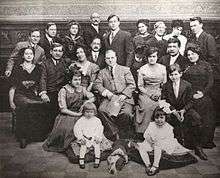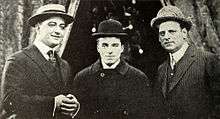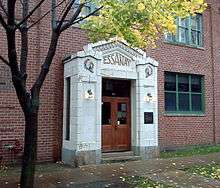Essanay Studios
The Essanay Film Manufacturing Company was an early American motion picture studio. The studio was founded in 1907 and based in Chicago, and later had an additional film lot in Niles Canyon, California. Its stars included, Francis X. Bushman, Gloria Swanson and studio co-owner, actor and director, Broncho Billy Anderson. It is probably best known today for its series of Charlie Chaplin comedies. In the 1920s, after it merged with other studios, it was absorbed into Warner Bros.

Founding
The studio was founded in 1907 in Chicago by George K. Spoor and Gilbert M. Anderson, originally as the Peerless Film Manufacturing Company. On August 10, 1907, playing on the founders initials the name was changed to Essanay ("S and A").[2][3]
Essanay was originally located at 496 Wells Street (modern numbering: 1300 N. Wells). Essanay's first film, "An Awful Skate, or The Hobo on Rollers" (July 1907), starring Ben Turpin (then the studio janitor), produced for only a couple hundred dollars, grossed several thousand dollars in release. The studio prospered and in 1908 moved to its more famous address at 1333–45 W. Argyle St in Uptown, Chicago.[4]

Leading players and staff
Essanay produced silent films with such stars (and stars of the future) as George Periolat, Ben Turpin, Wallace Beery, Thomas Meighan, Colleen Moore, Francis X. Bushman, Gloria Swanson, Ann Little, Helen Dunbar, Lester Cuneo, Florence Oberle, Lewis Stone, Virginia Valli, Edward Arnold, Edmund Cobb and Rod La Rocque. The mainstay of the organization, however, were studio co-owner, Anderson, starring in the very popular "Broncho Billy" westerns, and Charlie Chaplin was at one time its biggest star.[5][6]
Allan Dwan was hired by Essanay Studios as a screenwriter and developed into a famous Hollywood director. Louella Parsons was also hired as a screenwriter and went on to be a famous Hollywood gossip columnist.[7] Both George K. Spoor (in 1948) and Gilbert M. "Broncho Billy" Anderson (in 1958) received Oscars, specifically Academy Honorary Awards, for their pioneering efforts with Essanay.[8][9]
Productions
Essanay's famous movies, include the first American film version of A Christmas Carol and the first Jesse James movie, The James Boys of Missouri in 1908. They also produced the very first American Sherlock Holmes film in 1916 with William Gillette. The first film comedy pie in the face gag is believed to have hit Essanay star Ben Turpin in Mr. Flip (1909).[10] Finally, Essanay produced some very early cartoons; Dreamy Dud was the most popular character.[11]
Due to Chicago's seasonal weather patterns and the popularity of westerns, Gilbert Anderson took a part of the company west, first to Colorado. He told The Denver Post in 1909, "Colorado is the finest place in the country for Wild West stuff,"[12] The western operations moved to California, but traveled between Northern to Southern California seasonally. This included locations in San Rafael, just outside San Francisco, and Santa Barbara. Essanay opened the Essanay-West studio in Niles, California, in 1912, at the foot of Niles Canyon, where many Broncho Billy westerns were shot, along with The Tramp featuring Charlie Chaplin. The Chicago studio, as well as the new Niles studio, continued to produce films for another five years, reaching a total of well over 1,400 Essanay titles during its ten-year history.
Chaplin

In late 1914, Essanay succeeded in hiring Charlie Chaplin away from Mack Sennett's Keystone Studios, offering Chaplin a higher salary and his own production unit. Chaplin made 14 short comedies for Essanay in 1915, at both the Chicago and Niles studios, plus a cameo appearance in one of the Broncho Billy westerns. Chaplin's Essanays are more disciplined than the chaotic roughhouse of Chaplin's Keystones, with better story values and character development. The landmark film of the Chaplin series is The Tramp (1915),[13] in which Chaplin's vagabond character finds work on a farm and is smitten with the farmer's daughter. Chaplin injected moments of drama and pathos unheard of in slapstick comedies (the tramp is felled by a gunshot wound, and then disappointed in romance). The film ends with the famous shot of the lonely tramp with his back to the camera, walking down the road dejectedly, and then squaring his shoulders optimistically and heading for his next adventure. Audiences responded to the humanity of Chaplin's character, and Chaplin continued to explore serious or sentimental themes within comic situations.
Attempting to capitalize on the popularity of Chaplin, the studio in 1915 had its cartoon character Dreamy Dud in a Chaplin themed short Dreamy Dud Sees Charlie Chaplin in which Dud watches a Chaplin short.[14]
Chaplin's stock company at Essanay included Ben Turpin, who disliked working with the meticulous Chaplin and appeared with him in only a couple of films; ingenue Edna Purviance, who became his off-screen sweetheart as well; Leo White, almost always playing a fussy continental villain; and all-purpose authority figures Bud Jamison and John Rand.
Chaplin disliked the unpredictable weather of Chicago and left after only one year for more money and more creative control elsewhere. His departure caused a rift between founders Spoor and Anderson. Chaplin was the studio's biggest moneymaker, and Essanay resorted to creating "new" Chaplin comedies from file footage and out-takes. Finally, with Chaplin off the Essanay scene for good, Essanay signed French comedian Max Linder, whose clever pantomime, often compared to Chaplin's, failed to match Chaplin's popularity in America.
V-L-S-E, Incorporated
In 1915, the Essanay entered into an agreement, in a last-ditch effort to save the studio, with Vitagraph Studios, Lubin Manufacturing Company, and Selig Polyscope Company to form a film distribution partnership known as V-L-S-E, Incorporated.[15] It was orchestrated by Chicago distributor George Kleine. Only the Vitagraph brand name continued into the 1920s, and was absorbed by Warner Brothers in 1925.
Final years
George K. Spoor continued to work in the motion picture industry, introducing an unsuccessful 3-D system in 1923,[16] and Spoor-Berggren Natural Vision, a 65 mm widescreen format, in 1930. He died in Chicago in 1953. G. M. Anderson became an independent producer, sponsoring Stan Laurel in a series of silent comedies. Anderson died in Los Angeles in 1971.
The Essanay building in Chicago was later taken over by independent producer Norman Wilding, who made industrial films. Wilding's tenancy was much longer than Essanay's. In the early 1970s, a portion of the studio was offered to Columbia College (Chicago) for a dollar but the offer lapsed without action. Then it was given to a non-profit television corporation which sold it. One tenant was the midwest office of Technicolor. Today the Essanay lot is the home of St. Augustine's College, and its main meeting hall has been named the Charlie Chaplin Auditorium.[17]
References
- "Chicago Landmarks - Landmark Details". cityofchicago.org. Retrieved 26 April 2017.
- Grossman, James R. (2004). The Encyclopedia of Chicago. University of Chicago Press. pp. 293–294. ISBN 0-226-31015-9.
- Arnie Bernstein, Hollywood on Lake Michigan: 100 Years of Chicago & the Movies, Lake Claremont Press, 1998, p. 37. ISBN 978-0-9642426-2-3.
- Phillips, Michael (2007-07-22). "When Chicago Created Hollywood". Chicago Tribune.
- Swanson, Stevenson (1996). Chicago Days. Contemporary Books. pp. 88–89. ISBN 1-890093-04-1.
- Heise, Kenan; Mark Frazel (1986). Hands on Chicago. Bonus Books. pp. 60. ISBN 0-933893-28-0.
- Barbas, Samantha (2005). The First Lady of Hollywood: A Biography of Louella Parsons. California: University of Calinfornia Press. pp. 9. ISBN 0-520-24213-0.
Louella Parsons.
- "Academy Awards, USA: 1948". IMDb. Archived from the original on 2007-07-02. Retrieved 2007-07-01.
- "Academy Awards, USA: 1958". IMDb. Archived from the original on 2007-10-28. Retrieved 2007-07-01.
- Smith, Michael Glover; Selzer, Adam (2015-01-20). "Flickering Empire: How Chicago Invented the U.S. Film Industry". Columbia University Press. ISBN 9780231850797. Retrieved 2019-05-24.
- Lenburg, Jeff (1999). The Encyclopedia of Animated Cartoons. Checkmark Books. p. 26. ISBN 0-8160-3831-7. Retrieved 6 June 2020.
- "The Essanay Company Out West" From The Denver Post, reprinted in The Moving Picture World, Vol. 5, No. 23, December 4, 1909. Excerpted in Pratt, George C., Spellbound In Darkness: A History of the Silent Film New York Graphic Society. p 127. ISBN 0-8212-0489-0
- "Chaplin's The Tramp – 'New' Views of One of Cinema's Most Iconic Scenes". Silent Locations. 16 October 2016. Retrieved 15 April 2020.
- Kevin Scott Collier. The Animated Silent Charlie Chaplin Cartoons. Cartoon Research (May 20, 2019).
- Wagenknecht, Edward (13 October 2014). "The Movies in the Age of Innocence, 3d ed". McFarland. Retrieved 9 September 2018 – via Google Books.
- "Natural Vision Picture", The New York Times, August 21, 1923, p. 6.
- McNulty, Elizabeth (2000). Chicago: Then and Now. Thunder Bay Press. p. 121. ISBN 1-57145-278-8.
Further reading
- David Kiehn, Broncho Billy and the Essanay Film Company, Farwell Books, 2003. ISBN 978-0-9729226-5-4.
External links
- Essanaystudios.org: Official Essanay Studios landmarks website
- Nilesfilmmuseum.org: Niles−Essanay Silent Film Museum — at Essanay Studios West, located in Niles Canyon, East San Francisco Bay Area, California.
- Nilesfilmmuseum.org: "Story of Essanay Studios in Niles"
- History TV: "An animated history of Essanay Studios — detailed history and extensive filmography.
- "Chicago Magazine.com: "Reel Chicago" (May 2007) — by Robert Loerzel.
